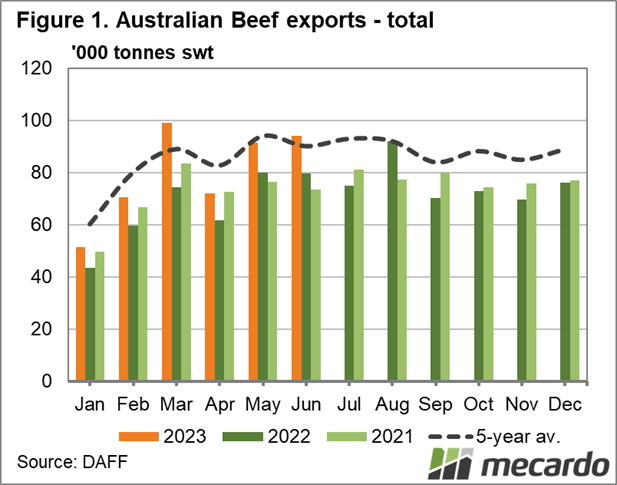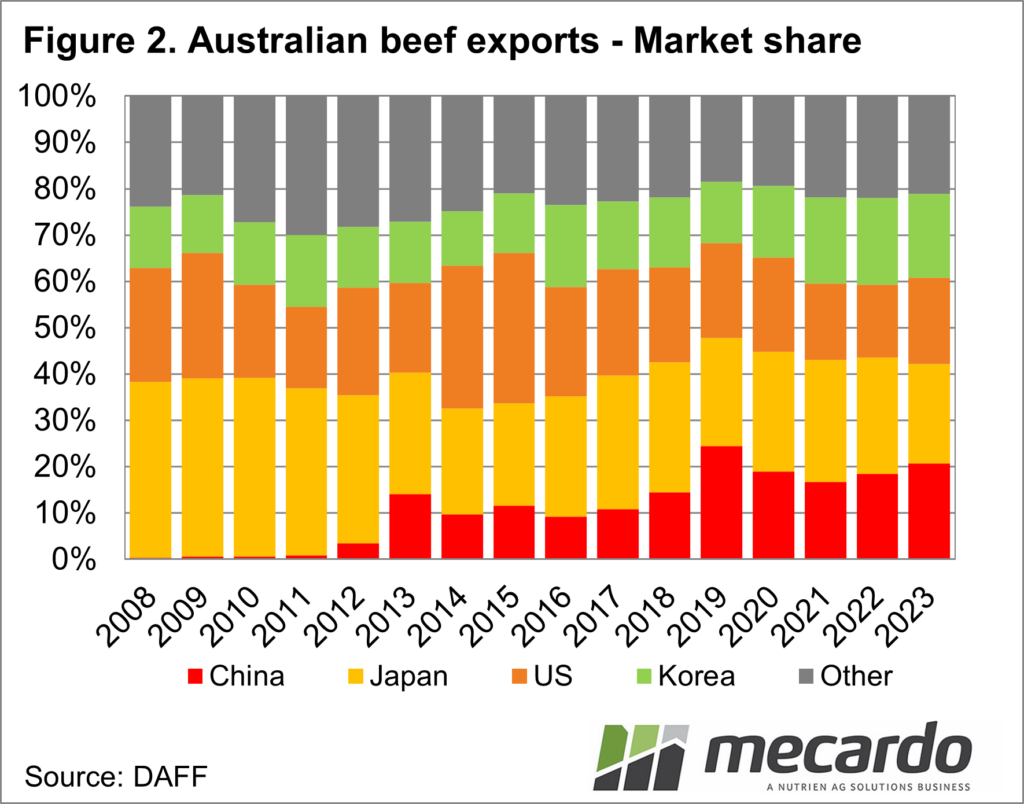Australian beef export volumes are gaining back some of the traction they lost over the past two years of record domestic prices. Increasing by 17% year-on-year for the January to June period, they’ve spent three of the past six months close enough to five-year-average figures. While still more than 100,000 tonnes behind the record volumes exported in 2019, all indications are that the trade has the capacity to head back in that direction.
Historically June is one of the strongest export months for Australian beef, and with 94,009 tonnes heading offshore, it was above the five-year average and 18% higher year-on-year for the month. For the year-to-date, the first six months of 2023 are still tracking below the five-year average for the period, however, trailing by 4%. Driving the increase in June was the US and China. Volumes to America were up 11% above the average, and nearly 50% higher for the month year-on-year, while China took 18% more than the five-year average for June, and 29% more than they did for the same month in 2022.
Market share-wise, Japan remains the largest importer of Australian beef so far in 2023, but only just, less than 1% ahead of China. It is also the only major market trailing last year’s figures. According to Rabobank’s latest report, full supply chains due to slower economies are one of the reasons Japan is taking less beef. It quotes Japanese beef inventory volume (as of April, the latest data available) as being at its highest level in more than three decades. And there are reports that Japan is not the only one of Australia’s beef markets that has full cold stores.
That said, beef exports to China are up 26% year-on-year for the year-to-date, and 7% higher than the five-year average. Reflecting the increased supply and seasonal ability to finish cattle, grassfed beef exports to China have increased by 56% this year, compared to grainfed which have gained just 10%. This June was the second-highest volume of beef sent to China in June on record, only eclipsed by 2019.
The US has imported 18% more Australian beef for 2023 so far and has increased its market share by 3% on last year. While our current 90CL (US imported lean beef) price is currently stronger than it was 12 months ago, Steiner Consulting Group has been quoting a softening imported lean beef market in the US in recent weeks, with extra supply out of Australia as one of the key reasons. And they expect this to continue, with beef volumes next July from Australia into the US expected to be double the same month last year.
What does it mean?
Australian cattle slaughter for the year-to-date has increased by more than 25% year-on-year, and therefore it is not surprising exports have also been on the rise. Steiner’s most recent global beef market review, released just last week, had Australia making up 11% of all beef exports, with only the US and Brazil ahead of that.
Export growth for the remainder of 2023 may be supported by the supply coming out of Australia which will likely continue into the spring, as well as domestic cattle prices which aren’t expected to experience a significant rise. However, there’s plenty of talk of economic slowdowns across many markets, which could temper export demand in the coming months, as well as impact export pricing. This could limit the level of support for Australian cattle returns.
Have any questions or comments?
Key Points
- Australian beef exports are benefiting from lower prices and higher supply, up 17% for the first six months of the year.
- Beef volumes to China have been tracking above the five-year average for the past four months.
- Japan is still Australia’s largest market for the year but has lost market share to both the US and China in 2023.
Click on figure to expand
Click on figure to expand
Data sources: Meat and Livestock Australia, Steiner Consulting Group, Mecardo














